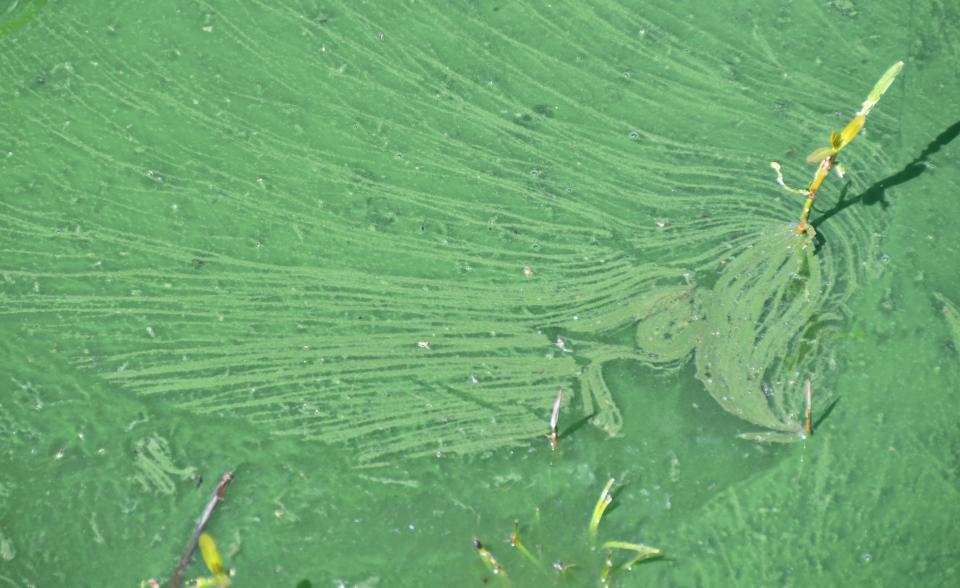Is that nasty algae making you sick? Florida researchers want to know
Ever wonder if all that nasty looking algae in the Indian River Lagoon or nearby canal, lake or pond is making you sick, shortening your memory and/or your years? What about those red and brown tides?
Florida scientists want you to volunteer to help figure some of those things out.
The University of Miami, Florida Atlantic University, the University of Florida and Florida Gulf Coast University are sharing a $650,000 state grant to study long-term health effects from harmful algal blooms. It's called the DISPEL study.
What is the DISPEL study?
It stands for Diversity and Innovation in Screening and Prevention of Exposure over the Long-term (DISPEL) and examines long-term effects blue-green algal toxins have on Florida communities.
What are immediate health risks from toxic algae?
According to state health and environmental officials, if ingested water contaminated with toxic cyanobacteria can cause "nausea, vomiting and, in severe cases, acute liver failure." So people should avoid swimming in or drinking water from these waters while blue-green algae is blooming.
Cyanobacteria are among the most abundant species on earth, she said. But stagnant waters can brew health risks for people and their pets. Biologists refer to it as "residence time," or how long a given algae cell or particle of anything else tends to linger within certain defined areas of waterways.
"The residence time of water in a system plays a role," Kim Popendorf said, assistant professor of Ocean Sciences at The University of Miami Rosenstiel School. "If it's bloom season, I think you really proceed with caution."
How are they going about it?
The researchers provide test kits for citizen scientist volunteers to do water sampling, as well self-collecting "microbiome swabs" for bacteria that include a swab of their skin (forearm), saliva and fecal samples. The baseline and follow-up assessment also include pulmonary function tests, the DISPEL site says.
The project established groups of communities that may be exposed to harmful algal blooms to identify the impacts of recurrent low-dose exposure to algal blooms.
Long-term biomarker and health monitoring will provide information on possible toxin exposure routes (such as inhalable airborne particles) and exposure-associated degenerative health effects not well established in scientific inquiry.
What are the project priorities?
According to UM, they are as follows: prevention of impacts from exposure; improved treatment of impacts from exposure to algal toxins; reducing health disparities from algal toxin exposures due to race, ethnicity or income; better screening accuracy for high-risk groups and earlier detection or prevention of algae-related illness.

What are potential outcomes of the research?
UM says, ".. improved environmental and/or human toxin tests and a better understanding of the health risks for people with variable exposure to the toxins (from the occasional beach visitor to those with long-term occupational exposures)."
How can you sign up for the study?
Anyone in Florida is interested in joining the study can fill in their info on the researchers' webpage at www.dispelhabstudy.org/contact-us, or reach by email to Dr. Alberto Caban-Martinez at ACaban@med.miami.edu, or to the study coordinator Addison Testoff at addison.testoff@earth.miami.edu.
Have any algae blooms been reported recently in east Central Florida?
Yes. On Tuesday, Aug. 22 toxins associated with blue-green algae were detected in the Stick Marsh in the Upper St. Johns River.
Blue-green algae blooms are a periodic problem in Lake Washington, one of the main sources of water supply in Brevard County.
What is recent federal research finding?
A report this summer by the U.S. Centers for Disease Control and Prevention found 92% of animals that got ill from toxic algae blooms died. Those blooms peak in August, the study found, with 90% of the 368 harmful algae blooms occurring in lakes, reservoirs and other fresh waters.
What are the Florida researchers finding?
One study Popendorf coauthored in 2021 found that commercially available face masks and air conditioner filters the algae's airborne toxins.
But face masks and AC filters with high filter performance ratings "efficiently removed toxin-containing particles to below limits of quantification."
"Our findings suggest that face masks and commercially available AC filters with high filtration efficiency ratings are suitable mitigation strategies to avoid indoor and outdoor air exposure to aerosolized HAB toxins," the researchers wrote.
Where can I see the latest algae sample results?
ProtectingFloridaTogether.gov.
Where should I report harmful algal blooms?
Report symptoms from exposure to a harmful algal bloom or any aquatic toxin to the Florida Poison Information Center. Call 1-800-222-1222 to speak to a poison specialist.
This article originally appeared on Florida Today: Florida researchers seek volunteers for statewide algae health risks

